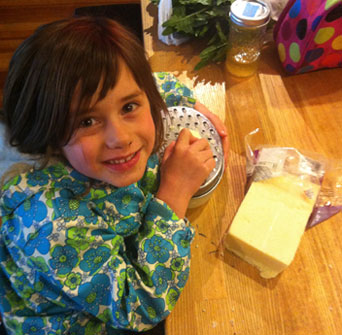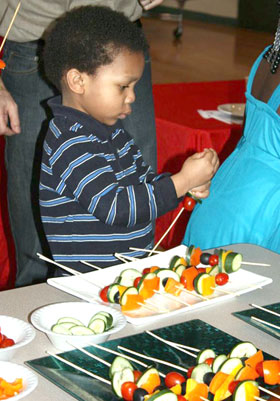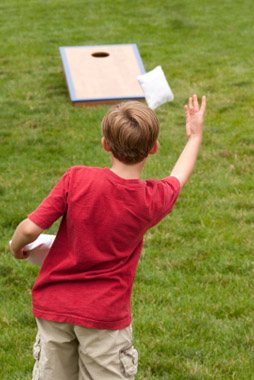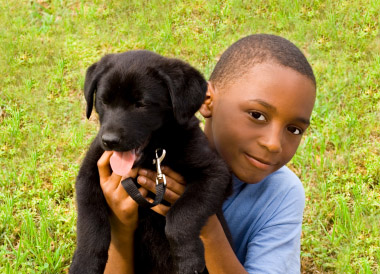Newsletter: June 2013
How Many Cooks in your Kitchen?

Now that the school year is winding down, you might want to break out of a dinner rut and try something new. For instance, now might be the perfect time to involve your kids more in making and/or serving dinner. By inviting everyone to contribute to dinner, the experience not only becomes more fun, but more meaningful for everyone (and you get some help!).
This month we offer a few creative ways to get your kids pitching in around dinner, as well as a simple veggie kebab recipe you can make together, games ideal for the warmer weather and conversation starters focused on this month’s theme: loyalty.
Tips for Getting Everyone Involved in Dinner
- Invite your child to help cook. Choose activities that are appropriate for his or her skill level. Kids can stir a pot, crumble the cheese, set the timer, measure ingredients, pick leafy green vegetables off their stems, push the button on the blender, crack eggs or whisk anything. With supervision, older children can also chop ingredients. Here, The Family Dinner Project’s Lynn Barendsen shares how she gets her kids involved in cooking and planning meals.
- Get the right tools. If your child seems interested in cooking, purchase a few products for pint-sized chefs, like safety knives and measuring cups. Curiouschef.com has a pretty good selection.
- Watch cooking shows together. Cooking shows or competitions on the Food Network can do wonders for getting kids interested in making meals. Our own Cooking with Kids series includes videos of kids making such items as hummus, monkey bread and “offal onions” (curious what that is? Check it out).
- Create a weekly dinner ritual. For example, maybe every Sunday your kids invite friends to dinner or to dessert. Sundaes, anyone?
- Ask your teen to choose music or a recipe for dinner. Then use this to spark a conversation. Ask “why this particular song or recipe?” Or alternate between your child’s favorite songs and your own, which could spark an interesting conversation about music.
These tips come from our do-it-yourself program, Food, Fun and Conversation: 4 Weeks to Better Family Dinners, scheduled to launch very soon. We’ll keep you posted!
![]()
Food: Veggie Kebabs
 With the days growing longer, getting dinner on the table when my kids’ stomachs start grumbling is harder and harder. They want to play on the playground longer; I want to mess around in the yard after work. This means dinner ends up being served later than it should.
With the days growing longer, getting dinner on the table when my kids’ stomachs start grumbling is harder and harder. They want to play on the playground longer; I want to mess around in the yard after work. This means dinner ends up being served later than it should.
Here’s where the veggie kebab comes in. It’s helpful to think about the food before dinner as an appetizer rather than a “snack.” Snacks tend to be bowls of cereal, granola bars, chips and other unhealthy items. Appetizers tend to be veggies, fruits, cheeses and much more wholesome choices. Our favorite go-to appetizer is the veggie kebab, which gets healthy food into your kids while they’re still really hungry, so there’s less fighting about eating veggies during dinner.
Veggie Kebab
INGREDIENTS
- Cherry tomatoes
- Cucumbers
- Olives
- Red/yellow/orange peppers
- Cauliflower
- Sugar snap peas
Optional ingredients:
- Cheese cubes
- Salami cubes
- Anything else you can poke a hole in!
INSTRUCTIONS
- This is a simple item for parents and kids to make together. First, make sure you have grilling skewers. Your kids, if old enough and with appropriate supervision, can cut the vegetables into cubes or disks. Only the cherry tomatoes and olives should be served whole. Kids can carefully (and again, with the close supervision of an adult for young children) place items on the skewers while mixing and matching colors to create a rainbow. Note: If your skewers are new or very sharp, you may want to dull the tip first.
- Finally, serve with hummus, ranch dressing or nothing at all. Voila! You’re done.
![]()
Fun: Games & Activities
 Lawn Games, Anyone?
Lawn Games, Anyone?
Now that it’s warmer out and the days are longer, why not get the family outside right after dinner or between dinner and dessert for a game of cornhole (also known as corn toss)? Cornhole is a lawn game with an interesting history in which players take turns throwing cornhole bags at a raised platform with a hole in the far end. A bag in the hole scores 3 points, while one on the platform scores 1 point. Play continues until a team or player reaches the score of 21. Other possibilities include good old-fashioned croquet, horseshoes, bocce, volleyball, tetherball, Frisbee, soccer, you name it! The sky (literally – as long as you can still see each other) is the limit.
I’m Going on a Picnic…
As long as your kids know the alphabet, they can play this one. You start with letter “A” and say “I’m going on a picnic and I’m going to bring… an apple” (or anything else that starts with the letter “A”). Then the next person repeats what you said, and adds something that starts with the letter “B.” The game keeps going like this, with each person on his or her turn repeating what the last person said, and adding a new item based on the next letter, all the way to the letter Z. It’s a great memory game, and can get very silly as you go along. Better yet, why not play it while you’re actually having a picnic in the backyard? (And then play a game of cornhole, as noted above).
Higglety Pigglety (say that 10 times fast!)
Here’s a good game to play (inside or outside) after dinner with kids approximately 8-10 and up. One person thinks of a rhyming pair of words, like Funny Bunny. Then the person gives clues that are synonyms for the two words—hilarious furry mammal, for example. Additionally, the person clues everyone in to how many syllables each word is by using the phrases “higglety pigglety” (for 3 syllable words), “higgy piggy” (for 2 syllable words), or “hig pig” (for 1 syllable words). So Funny Bunny is a “higgy piggy,” while Old Mold is a “hig pig.” Everyone tries to guess. Whoever guesses the right answer first comes up with the next one. Here’s some ideas to get you started.
What’s your family’s favorite game? We want to feature one reader’s game suggestion in each of our future newsletters! Email us! If your game is chosen, we’ll share it in our newsletter (and give you credit of course), as well as send you a fashionable and eco-friendly tote bag from The Family Dinner Project!
![]()
Conversation: Table Questions
Each month our Conversation section offers questions to inspire kids to think through important and meaningful topics, and spark family discussion. This month our questions focus on loyalty. For younger kids, you may want to give a brief explanation or example of loyalty before you begin.
2-7 Years Old:
 What does it mean to be loyal? How is this different than just being a good friend or a good sibling, daughter, son, etc.?
What does it mean to be loyal? How is this different than just being a good friend or a good sibling, daughter, son, etc.?- Talk about a time that you have shown loyalty to a friend. How about a family member?
- How do some of your favorite cartoon characters show loyalty to each other? Think of Batman and Robin or Shaggy and Scooby, for example.
- How do animals show their loyalty? If you have a pet, how do you show loyalty to each other?
8-13 Years Old:
- Do you recall a time when it was hard to be loyal? An experience where you needed to make a difficult choice? A time when you needed to make sacrifices in order to show your loyalty?
- Is it always a good thing to be loyal? When might it not be?
- If a friend asks you to keep a secret that you don’t feel comfortable keeping, what would you do?
14-100 Years Old:
- Mark Twain said, “Loyalty to the country always. Loyalty to the government when it deserves it.” What’s the difference between the two, and how would you demonstrate each?
- When athletes change teams or people change jobs and go to work for a competitor, is that disloyal? Why or why not?
- How do you think the way we demonstrate loyalty changes (or should change) as we get older?
Recent Newsletters
- Family Dinner Has Gotten Expensive - April 2024
- Is it the Family, Or the Dinner? - March 2024
- Black History Month at Family Dinner - February 2024
- New Year, Same You - January 2024
- Sharing the Holiday Load - December 2023
- What’s Your Thanksgiving Story? - November 2023
- Family Dinner: Stressful, or Stress-Busting? - October 2023
- New Ways to Ask “How Was Your Day?” - September 2023
- Low Stress, Low Cost, Low Waste Dinner Hacks - August 2023
- Family Dinner After Divorce - July 2023
- Preparing Teens for Dinner Independence - June 2023
- Talking to Kids About Technology - May 2023
